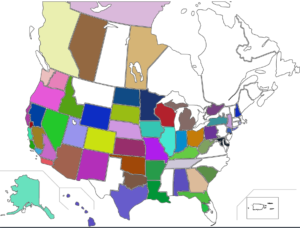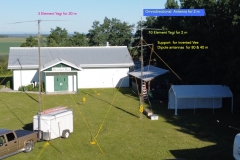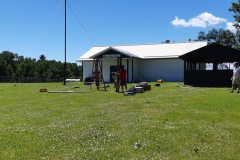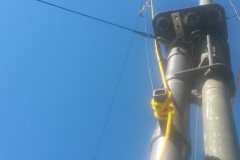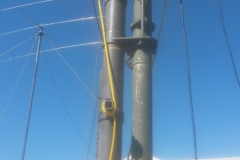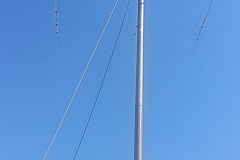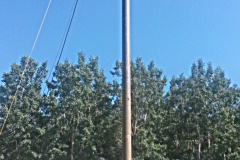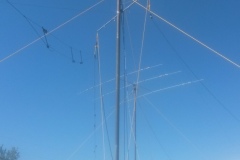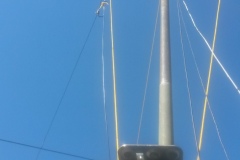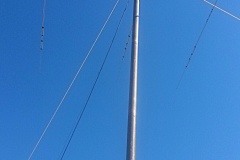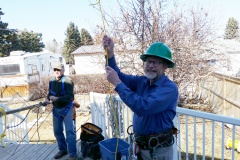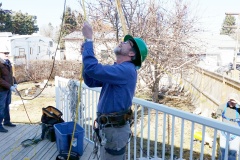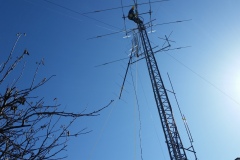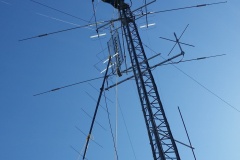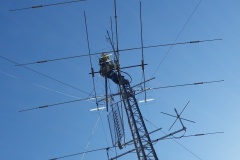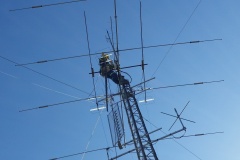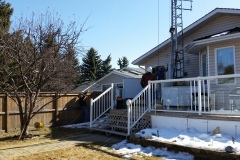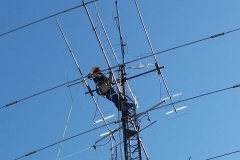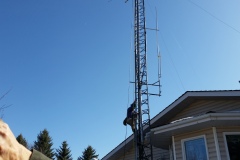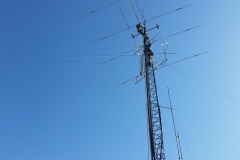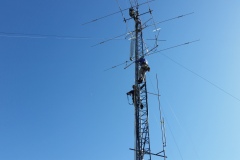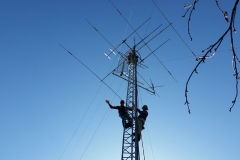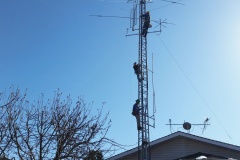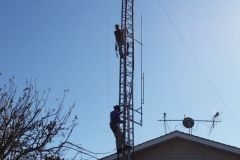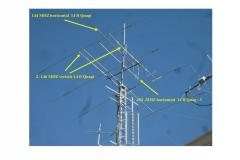- Home
- Registration
- Site Tools
- Articles
- Swap n Shop
- Contesting
- Grounding information for everyone
- History of the Central Alberta Amateur Radio Club
- CAARC owned Repeaters
- Club Repeater Info
- GMT Time Conversion Table
- VE/VA6 Incoming QSL Bureau
- Pine Lake Tornado Friday July 14, 2000.
- Amateur Radio to the Rescue
- CANWARN
- HAM Nation with Bob Heil K9EID
- Net info
- Events.
- ARES
- Links and On line study course.
- Field Day 2019
- Members D/L
- Forum/Swap and Shop
VE6BLD
Welcome to the CAARC web site. I have been a Ham since 1978 and I am active on most modes from HF to UHF Satellite communications.
Posts by VE6BLD

Field Day Pictures 2021
Jul 5th
Thanks to everyone who submitted these pictures. Be sure to check all four pages at the bottom of the first page for all the pictures.
These are the field day results as submitted to ARRL (Thanks VA6SGL ) Great job everyone!
VE6QE_FD_Report
Field Day Update.
Jul 5th
Thank you to all the hams for your help and participation in field day. The bands were wide open and operating conditions from the new site were excellent. We made just over 200 contacts. Everyone worked together to make field day a success. I will be adding a gallery of photos as soon as I receive them. If you have any photos please send them to me. We will be posting the total score submitted soon. Thanks again.
73 Bob VE6BLD
Temporary Rule Waivers for ARRL Field Day 2021:
Jun 9th
Temporary Rule Waivers for ARRL Field Day 2021:
For Field Day 2021 only, Class D stations may contact all other Field Day stations, including other Class D stations, for points. Class D and Class E stations are limited to 150 Watts PEP. (See Field Day rule 4.6)
- Eligibility: Field Day is open to all amateurs in the areas covered by the ARRL/RAC Field organizations and countries within IARU Region 2. DX stations residing in other regions may be contacted for credit and may submit entries as check-logs.
- Object: To work as many stations as possible on the 160, 80, 40, 20, 15 and 10 Meter HF bands, as well as all bands 50 MHz and above, and in doing so to learn to operate in abnormal situations in less than optimal conditions. A premium is placed on developing skills to meet the challenges of emergency preparedness as well as to acquaint the general public with the capabilities of Amateur Radio.
- Date and Time Period: Field Day 2021 will be held June 26-27. Field Day is ALWAYS the fourth full weekend of June, beginning at 1800 UTC Saturday and ending at 2059 UTC Sunday.
3.1. Class A and B (see below) stations that do not begin setting up until 1800 UTC on Saturday may operate the entire 27-hour Field Day period.
3.2. Stations who begin setting up before 1800 UTC Saturday may work only 24 consecutive hours, commencing when on-the-air operations begin.
3.3. No class A or B station may begin its set-up earlier than 0000 UTC on the Friday (Thursday afternoon or evening local time) preceding the Field Day period. Cumulative set-up time shall not exceed a total of 24 hours.
- Entry Categories: Field Day entries are classified according to the maximum number of simultaneously transmitted signals, followed by a designator indicating the nature of their individual or group participation. The minimum number of transmitters that must be claimed is one (1). Twenty (20) transmitters maximum are eligible for the purpose of calculating bonus points (2,000 points maximum). However, additional transmitters which may legitimately be used simultaneously will determine your entry category classification, but will not earn additional bonus points (i.e. 22 transmitters = 22A). The use of switching systems that allow for lock-outs in order to use multiple transmitters (i.e., an “octopusâ€) in an attempt to enter a lower-number-of-transmitters class are prohibited (i.e. using 2 transmitters that can transmit simultaneously, with two operators, and a lock-out system and entering class 1A). The use of simulcasting devices which allow a single operator to key and transmit on more than one transmitter at a time, is prohibited. Bonus stations, such as the GOTA station and satellite station do not count towards determining the number of transmitters for the class and do not qualify for transmitter bonus points.
4.1. (Class A) Club / non-club portable: Club or a non-club group of three or more persons set up specifically More >
NET CONROLLERS NEEDED!
May 9th
Hello everyone. We have lost one of our net controllers for the Monday night net, we are down to three. I am asking for anyone to please volunteer to help to be a net controller. If we get some new people it will not be a very big commitment for anyone. Running the Monday night net is very easy and it gives you great experience in case we have need for a net in an emergency. It is also a great way to meet local Hams and to help remember their names! We have a spread sheet you can use that will automatically fill in their name and location when you type their call in as they check in. To volunteer please send me an e-mail at
sparkyham(at)gmail(dot)com to volunteer for the net.
You can also just let me know by voice when you hear me on the QE repeater!
Thank you to the net controllers who run the net every Monday night.
73
Bob VE6BLD
CAARC Net Controller admin
RAC Presents CANWARN Spring Training Session: May 26
May 5th
RAC Presents CANWARN Spring Training Session: May 26
Click link below for more details
CANWARN (CANadian Weather Amateur Radio Network)

VE6BLD’s first try on an Electric Unicycle! TOO MUCH FUN!
Apr 27th
A few weeks ago I was at my son’s place in Okotoks and he helped me try his new Electric Unicycle. It was a very cold and windy day but after 3 tries I managed to go a few hundred feet! What a blast!
Click these links for my 3 best tries…
Dad’s 2nd Good Ride on Michael’s EUC This would be easier on a flat lawn with no wind!!
I may have to get one of these..
Grounding information for everyone
Apr 14th
Jim VE6JHK passed this information video on to me after we had a discussion on the air with a few hams the other day. Thanks Jim.
VE6BLD 144 MHZ SSB horizontal Antenna install
Mar 18th
VE6BLD 144 MHZ SSB horizontal Antenna install. We had a beautiful March plus 15 degree day to get my SSB Quagi antenna up the tower. Many thanks to VE6CIA Garry, VA6MPM Paul and VE6MIM Mike for helping with this rather difficult install. I have quite a few other antenna that could have posed a problem but we found a hole to pull up the 14 foot long Quagi and get it installed above the HF beam, 2 m Quagis, 70 CM Quag-v antennas. Garry climbed to stand on the top plate of the tower and then stood on the HF antenna boom to be able to reach above the 440 MHZ Quagi. He was able to install the new quagi on the verticlal mast of the 14 foot long vertical folded dipole I used for my commercial antenna for my business. He would have been reaching up to about the 63 foot height! The antenna checked out with a great SWR. Thanks all three of you for all the great help!! I should now be able to work Calgary and Edmonton easily on SSB simplex with the other weak signal hams. I an barely remember when VE6BGT Skip and I with Sarina’s and some other hams help built the whole tower and antenna 32 years ago! Check out the great pictures Sarina took in this Gallery.
After you close the picture browser you will have to refresh your page to go back( New problem I have to figure out now !!)

